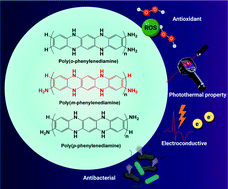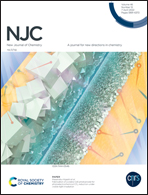Electroconductive and photoactive poly(phenylenediamine)s with antioxidant and antimicrobial activities for potential photothermal therapy
Abstract
In recent years, polyaniline derivatives such as poly(phenylenediamine)s have attracted the attention of researchers due to their better solubility and good optical and electrical properties. In the current work, poly(ortho-phenylenediamine) (PoPDA), poly(meta-phenylenediamine) (PmPDA), and poly(para-phenylenediamine) (PpPDA) were synthesized by the chemical oxidation polymerization method in doped and undoped forms. Polymer samples were characterized by 1H-NMR, FT-IR, EDX, XRD, FESEM, UV-vis, and TG-DTG analyses. The impact of the doped and undoped forms of poly(phenylenediamine)s on their solubility, electrical conductivity, viscosity, optical activity, and thermal stability was studied. In addition, biological activities (e.g. antioxidant and antibacterial activities and cell toxicity) were also evaluated. The electrical conductivity of the undoped poly(phenylenediamine)s was in the range of 6.0 × 10−12 to 8.0 × 10−14 S cm−1, while the electrical conductivity of the doped poly(phenylenediamine)s was in the range of 8.5 × 10−12 to 1.9 × 10−10 S cm−1. The doped forms of PoPDA and PpPDA were partially soluble in dimethyl sulfoxide (DMSO), N-methyl pyrrolidone (NMP), and dimethylformamide (DMF) and insoluble in tetrahydrofuran (THF), methanol, and water solvents. According to the results, undoped PoPDA, doped PoPDA, and undoped PmPDA showed less than 25% toxicity toward human dermal fibroblast (HDF) cells at their minimum inhibitory concentrations on L. monocytogenes. The results of the photothermal activity study displayed that, in all the poly(phenylenediamine)s, the doped samples after ten minutes of irradiation under laser light had a temperature between 34.5 and 46 °C, while the undoped samples showed a temperature between 34 and 37 °C. The current study may shed light on the potential applications of these conductive and photoactive materials in regenerative medicine such as bacteria-accompanied wound treatment.



 Please wait while we load your content...
Please wait while we load your content...